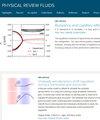Newtonian fluid dynamics in a misaligned parallel-plate rheometer
IF 2.5
3区 物理与天体物理
Q2 PHYSICS, FLUIDS & PLASMAS
引用次数: 0
Abstract
A parallel-plate rotational rheometer measures the viscosity of a fluid by rotating the top plate relative to the bottom plate in order to induce a shear on the fluid and measuring the torques and forces that result as a function of the induced rotation rate. Manufacturing imperfections can often lead to unintentional misalignment of the plates of the rheometer, where the top and bottom plates are not perfectly parallel, and this misalignment can affect the fluid dynamics inside the rheometer. This study examines the effect that misalignment has on the viscosity measurements of Newtonian fluids in the limit of small rheometer gap heights. A theoretical model for the behavior of a general Newtonian fluid in a misaligned rheometer with a small gap height is derived using perturbation expansions. The theoretical results show that at small gap heights, misalignment can produce additional secondary velocity components and pressures in the fluid, which affect the forces and moments in the rheometer. In such cases at small Reynolds numbers, the dominant forces and moments acting on the top plate of the rheometer are the viscous force in the direction parallel to the tilt axis, the pressure moment in the direction perpendicular to the tilt axis and in the cross-sectional plane, and the viscous moment in the direction along the height of the rheometer. These forces and moments on the top plate were found to increase as the misalignment tilt angle increased, leading to an increase in the error of viscosity measurement by the rheometer. Three-dimensional numerical simulations validate the theoretical predictions.

错位平行板流变仪中的牛顿流体动力学
平行板旋转流变仪通过旋转顶板和底板来测量流体的粘度,从而对流体产生剪切力,并测量作为诱导旋转速率函数的扭矩和力。制造缺陷往往会导致流变仪的顶板和底板无意中错位,即顶板和底板并非完全平行,这种错位会影响流变仪内部的流体动力学。本研究探讨了在流变仪间隙高度较小的情况下,错位对牛顿流体粘度测量的影响。利用扰动展开法推导出了一般牛顿流体在间隙高度较小的错位流变仪中的行为理论模型。理论结果表明,在间隙高度较小时,错位会在流体中产生额外的次级速度分量和压力,从而影响流变仪中的力和力矩。在这种情况下,当雷诺数较小时,作用在流变仪顶板上的主要力和力矩是平行于倾斜轴方向的粘性力、垂直于倾斜轴方向和横截面上的压力力矩以及沿流变仪高度方向的粘性力矩。这些作用在顶板上的力和力矩会随着错位倾斜角的增大而增大,从而导致流变仪测量粘度的误差增大。三维数值模拟验证了理论预测。
本文章由计算机程序翻译,如有差异,请以英文原文为准。
求助全文
约1分钟内获得全文
求助全文
来源期刊

Physical Review Fluids
Chemical Engineering-Fluid Flow and Transfer Processes
CiteScore
5.10
自引率
11.10%
发文量
488
期刊介绍:
Physical Review Fluids is APS’s newest online-only journal dedicated to publishing innovative research that will significantly advance the fundamental understanding of fluid dynamics. Physical Review Fluids expands the scope of the APS journals to include additional areas of fluid dynamics research, complements the existing Physical Review collection, and maintains the same quality and reputation that authors and subscribers expect from APS. The journal is published with the endorsement of the APS Division of Fluid Dynamics.
 求助内容:
求助内容: 应助结果提醒方式:
应助结果提醒方式:


